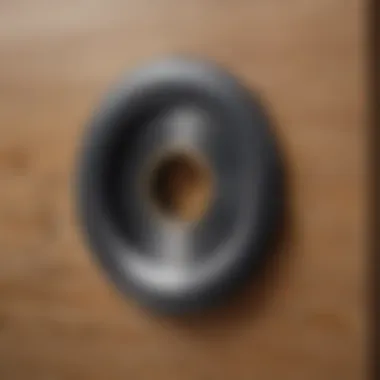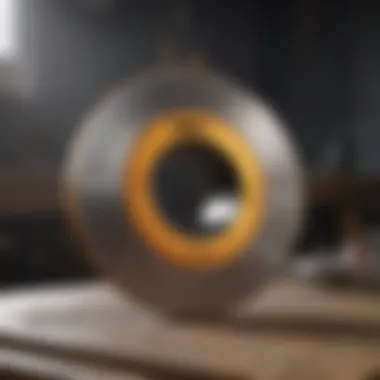Choosing the Best Hole Saw for Metal Doors


Overview of Topic
When it comes to home improvement, the right tools can make all the difference. One such tool is the hole saw, particularly when it comes to metal doors. Choosing the appropriate hole saw is essential not just for achieving a clean cut but also for ensuring durability and efficiency. Understanding the nuances of what makes a hole saw effective for cutting through metal can greatly enhance your home projects.
Importance of the topic: The choice of a hole saw is more than just a casual decision. Metal doors are robust and require the right tools to create accurate openings without causing damage. This article offers a comprehensive guide that delves into the various characteristics of hole saws, the materials used, sizes available, and other usability factors that can impact performance. By exploring the specifics, homeowners can confidently select the best tool that aligns with their needs, ultimately leading to a successful project.
Common Challenges and Solutions
Working with metal doors often presents unique challenges. From inconsistent drilling to the risk of damaging your door, problems can arise. Here are a few common issues faced by homeowners along with their solutions:
- Issue: Vibration and wobbling during the cut.
Solution: Ensure that the hole saw is properly fitted to your drill. A snug fit minimizes wobbling and stabilizes the cut. - Issue: Dull blades leading to rough edges.
Solution: Choose a hole saw made from high-quality materials like bi-metal or carbide. Regularly inspect it for wear and replace it as necessary. - Issue: Heat buildup while cutting through metal.
Solution: Consider using cutting oil. Applying a small amount will reduce friction and help maintain the integrity of both the hole saw and your metal door.
"The right hole saw can turn a tough job into a walk in the park; selecting poorly can lead to nothing but frustration."
Product Recommendations
Navigating the vast array of hole saws can be overwhelming, but some brands stand out for their quality and performance:
- Milwaukee: Known for bi-metal hole saws, Milwaukee provides durability and precision. Their products often feature a unique tooth design that reduces tearing.
- DeWalt: Renowned for a wide selection of carbide-tipped hole saws, DeWalt combines toughness with reliability. Ideal for those who frequently work on metal doors.
- Lenox: Offers hole saws with a focus on longevity and efficiency. Their cobalt-enhanced products offer impressive cutting capabilities.
Benefits and features:
- Durability: High-quality materials withstand heavy use.
- Range of sizes: Fits various projects from small to larger cuts.
- Compatibility: Ease of use with different drill types, whether corded or cordless.
Step-by-Step Guides
Once you have chosen the right hole saw, the next step is implementation. Follow these practical steps for optimal results:
- Gather tools and materials: In addition to your hole saw, you'll need a drill, safety goggles, cutting oil, and a measuring tape.
- Measure and mark: Determine the location for the cut on your metal door. Use a measuring tape to find the center and mark it clearly to serve as a guide.
- Attach the hole saw: Ensure the correct fit with your drill. Tighten it securely according to the manufacturer’s instructions.
- Prepare the door: Place a wooden scrap piece behind the door. This helps prevent tearing on the opposite side when cutting.
- Apply cutting oil: Just a few drops around the area to be cut will assist in maintaining blade quality and performance.
- Begin drilling: Start at a low speed to create a pilot hole. Gradually increase the speed, applying steady pressure without forcing the saw.
- Complete the cut: Once through, gently withdraw the hole saw, and inspect the cut edges. If necessary, use a file to smooth out any rough edges.
By following this guide, you can confidently select a hole saw and execute your project with precision and ease. The result will not only enhance your space but also empower you with the experience and satisfaction of a job well done.
Understanding Hole Saws
When embarking on a project that involves drilling through metal doors, understanding the basics of hole saws becomes paramount. A hole saw isn't just a tool; it acts as a bridge between intention and execution. The right choice can significantly enhance your cutting efficiency while ensuring precision and durability in your work.
Getting familiar with how a hole saw works sets the stage for selecting the most effective one. It is not merely about making a hole; it is about ensuring that hole aligns with the requirements of your specific project, whether you're installing locks, handles, or other fixtures. Thus, knowing what a hole saw is and how it operates is an essential step.
Defining What a Hole Saw Is
A hole saw is a cylindrical cutting tool designed primarily for making holes in various materials. Unlike regular drill bits, a hole saw has a serrated edge around its circumference, allowing it to cut through materials with more efficiency. Think of it as a cookie cutter for metal—where precise, clean shapes are needed, this tool excels.
Generally constructed from either high-speed steel or bi-metal, these saws vary by size and application. They are often used in woodworking as well, yet when it comes to metal doors, specific features must be considered. Hole saws adapted for metal often have teeth designed to handle tougher material, ensuring they produce a smooth cut without tearing or aggressive friction that could cause damage.
How Hole Saws Function
The functionality of a hole saw is quite straightforward, but it's essential to grasp the mechanics behind it. When the hole saw is affixed to a drill, the drill's spinning motion activates the central drill bit within the hole saw. This bit comprises the pilot bit and serves to guide and stabilize the hole saw as it cuts through the metal.
The cutting process begins when the saw encounters the metal door. As it rotates, the serrated edges of the saw engage with the material, carving out a circular shape with minimal resistance. This process greatly reduces wear on the drill and allows for increased control over the cutting speed.
Keep in mind, the speed and pressure applied during drilling can greatly affect the results. Too much pressure can lead to overheating, while a gentle touch might not penetrate fully. It’s a delicate balance that one must master to achieve optimal results.
The effectiveness of a hole saw lies in understanding its operational principles and aligning them with your specific needs.
In summary, an informed understanding of what a hole saw is and how it functions can pave the way to making a well-considered choice. With the right knowledge in hand, you lay the groundwork for not just a successful drilling job but also for ensuring that your projects meet the desired standards.
Importance of Selecting the Right Hole Saw
Choosing the right hole saw may seem trivial at first glance, but it can make or break a project—especially when dealing with metal doors. Metal doors are often thicker and tougher than their wooden counterparts, so having the right tool is not just a matter of convenience, it’s essential for achieving clean cuts without extensive effort or damage. This section dives into the specific elements that highlight why selecting the right hole saw is so crucial.
Impact on Cutting Efficiency
When it comes to cutting through metal, efficiency is key. Using the proper hole saw directly affects how quickly you can complete a task. A compatible hole saw will slice through the material like a hot knife through butter, while the wrong one may struggle, resulting in wasted time.
- Material Match: Different hole saws are designed for specific materials. For example, bi-metal hole saws generally perform well on metal doors because they combine toughness with flexibility. On the other hand, a hole saw made for wood may simply get stuck, leading to frustrating delays.
- Tooth Design: Hole saws also vary in tooth design and spacing. More teeth allow for smoother cuts but can bog down the drill in thicker materials. Conversely, fewer but larger teeth create quicker cuts and can manage thicker gauges but might lead to less refined edges. Knowing the right balance can boost your cutting efficiency significantly.
Using a suitable saw not only saves time but also reduces the likelihood of needing time-consuming touch-ups later. A clean cut means the finished product is aesthetically pleasing and functional, sparing one from the extra work involved in making rough edges presentable.
Minimal Damage to Material
Every homeowner or DIY enthusiast has probably experienced the disappointment of damaging a project during assembly. Selecting the appropriate hole saw serves as a safeguard against such mishaps when cutting through metal doors.


- Precision Cuts: The right hole saw minimizes excessive metal shavings and burrs, leaving smoother edges that require much less work to finish. Instead of making your life harder, it allows you to enjoy a hassle-free experience, leading to better overall results.
- Reduced Pressure on Material: Choosing a hole saw that matches the thickness of the door helps in distributing pressure evenly. Too much pressure on the incorrect tool can warp or even break the door. A compatible hole saw will absorb and manage this pressure effectively, lowering the risk of damage.
"Investing in the right hole saw is like wearing the right shoes; it doesn’t just fit well, it performs well too."
Materials Used in Hole Saws
Understanding the materials used in hole saws is essential for anyone looking to cut through metal doors effectively. Each material brings its own set of benefits, costs, and technical strengths, impacting not only the performance of the hole saw itself but also the quality of the work and the longevity of the tool. In deciding which hole saw suits your needs best, you'll want to consider how each material performs under pressure, its durability, and its suitability for the specific thickness and type of metal you’re working with.
High-Speed Steel (HSS) Hole Saws
High-Speed Steel, or HSS, is a popular choice made from a high alloy of iron and carbon. It’s designed to withstand high temperatures, which can be handy when drilling through tougher metals. What’s more, they tend to be relatively affordable and widely available, making them a go-to option for DIY enthusiasts and professionals alike.
- Benefits:
- Considerations:
- Good for softer metals like aluminum and thin steel
- Resilient and holds a sharp edge well
- Cost-effective option
- Can wear out faster on harder metals
- Limited effectiveness on thicker materials
If you’re cutting through soft metals or working in a project where budget is a concern, HSS may just be the workhorse you need.
Bi-metal Hole Saws
Bi-metal hole saws combine two different metals to produce a tool with enhanced performance characteristics. Typically, this type features a high-speed steel cutting edge fused to a structural spring steel body. This fusion offers the best of both worlds: the durability and sharpness of HSS combined with the toughness of spring steel.
- Benefits:
- Considerations:
- Exceptional resistance to wear and shock
- Effective for a wide variety of materials, including wood and metal
- Versatile in both thickness and application
- Generally higher cost than HSS
- Can be overkill for simple DIY projects
For those who are serious about metalwork or own a thicker gauge metal door, bi-metal hole saws are an investment that often pays off with their durability and efficiency.
Carbide Tipped Hole Saws
Carbide tipped hole saws take durability a step further. The tips are made from tungsten carbide, a material renowned for its hardness and heat-resistance capabilities. These saws are tailored for cutting harder materials like stainless steel or exotic alloys. If you’re dealing with tough materials often, you might want to seriously consider this option.
- Benefits:
- Considerations:
- Offers unparalleled cutting speed and longevity
- Excellent for very hard materials
- Reduced heat build-up during drilling
- Higher upfront cost compared to other types
- May require more precise handling to avoid breakage
In summary, carbide tipped hole saws can be invaluable when dealing with demanding materials. They provide the cutting edge needed for professional-grade results.
Ultimately, your choice of material will depend on the specific requirements of your project, from the type of metal door you’re working with to your expected workload. Understanding these materials is a critical step in selecting the optimal hole saw.
Assessing Size Requirements
When it comes to working with metal doors, selecting the right hole saw size is non-negotiable. A proper fit not only ensures a cleaner cut but also minimizes potential damage to both the tool and the material being worked on. Understanding size requirements involves more than just picking a number; it incorporates the specific application of the hole saw, the thickness of the metal door, and the intended function of the holes you plan to create.
Measuring twice and cutting once may seem a bit cliché, yet it rings true in the world of hole saws. Incorrect sizing can lead to misaligned holes, requiring additional fixing work, and could even compromise the structural integrity of the door. Thus, proper assessment of the hole saw size helps save time and resources, ultimately translating to a smoother project flow.
Common Hole Sizes for Metal Doors
Metal doors come in a variety of thicknesses and ingress requirements, necessitating different hole sizes. Some prevalent hole diameters include:
- 1" (25mm): Commonly used for standard doorknob installations.
- 2.5" (64mm): Ideal for deadbolts and larger hardware fittings.
- 3" (76mm): Often suitable for electrical locks and sophisticated hardware setups.
It’s essential to measure your specific requirements before rushing to the hardware store. Taking detailed measurements helps in ensuring that you select a hole saw that meets the precise demands of your project. For instance, if equipping a door with a new handle, the size of the existing cutout can inform your selection.
Adjustable vs Fixed Size Hole Saws
In the market, you will encounter both adjustable and fixed size hole saws, each having their own merits and limitations. Knowing the advantages of each can greatly enhance your cutting experience.
Fixed Size Hole Saws: These are the standard option, available in a range of specific sizes. They provide reliability and are specifically designed to cut particular hole diameters. If you regularly work with standard fittings and installations, fixed hole saws can be your best friend as they come with easily readable markings for size identification.
Adjustable Hole Saws: Unlike their fixed counterparts, adjustable hole saws allow for on-the-fly size changes. This adaptability can be crucial if you’re encountering varying metal door sizes throughout your projects. While they may require a bit more initial setup and adjustment, they can save both time and money in the long run, especially if you’re working on multiple doors with different specifications.
In summary, when assessing size requirements, remember that precision is paramount. Ensure you’re armed with thorough measurements and an understanding of your project before diving into the purchase. Your choice between adjustable and fixed hole saws will significantly affect both the efficiency and quality of your work.
Key Features to Look for
When choosing a hole saw for metal doors, the specifics of what makes a tool effective can’t be brushed off. Selecting the right features can save time, ensure safety, and deliver quality results. It’s essential to highlight the attributes that contribute directly to successful cutting operations.


Primarily, keep in mind that the hole saw must withstand the rigors involved in cutting through tougher materials. The more you know about the essential characteristics, the better equipped you will be to make an informed choice. Here's a closer look at the key features that play a pivotal role.
Build Quality and Durability
Building a strong foundation in your choosing process starts with the quality of the hole saw. High-grade materials, such as bi-metal or carbide-tipped, significantly affect performance. They enable the tool to handle the heat generated during cutting. If your hole saw shatters or warps easily, your project can take a nosedive before it even begins.
It's wise to inspect the internal structure, as a solid core can enhance longevity. Look for hole saws that have additional coatings, which can reduce wear and tear during use. For instance, models with titanium coatings tend to resist corrosion better than standard steel, offering a longer life.
- Quality Material: Invest in high-quality steel for the base. This typically translates to higher sturdiness.
- Thickness: A thicker saw will withstand pressure better, reducing the chance of deformation.
- Finish: An improved finish can lead to smoother operations, dragging less and thus less heat production.
"The investment in a quality hole saw is trivial compared to the potential disruptions a poor tool can bring."
Ease of Use and Compatibility
You want your tool to feel like an extension of your hand, not a wrestling partner. When assessing ease of use, consider factors like design and adaptability. A hole saw that fits smoothly into your power drill enhances the drilling experience and reduces frustration.
Compatibility isn’t just about the fitting — it's also about how well the hole saw performs with different thicknesses of metal doors. Some hole saws feature adjustable depth settings, allowing more versatility when working with various materials.
Moreover, a handy feature to watch for is the ease of replacing the saw bit. Models that provide quick-change mechanisms can save you from wasting time during sometimes lengthy projects.
Factors to consider for ease of use:
- Weight: A lighter tool is easier to maneuver over an extended period.
- Grip: A well-designed handle provides better control, reducing the chance of error during cutting.
- Power Source: Cordless options offer the freedom of movement without being tethered to a wall.
In summary, by taking these key aspects into account, you're not just selecting a tool; you're enhancing your entire cutting experience. Remember, thoughtful features can significantly impact the quality of work delivered.
Analyzing Top Brands
When it comes to selecting the right hole saw for metal doors, understanding the landscape of available brands is crucial. Brands often embody quality, dependability, and user preferences shaped by years of experience. Each manufacturer brings unique innovations and design philosophies to the table, which can significantly influence your cutting experience. By analyzing top brands, you are better equipped to make informed choices that align with your project requirements.
By scrutinizing the features, feedback from users, and price points of various brands, you can discover what sets one brand apart from another. It allows you to weight your options against factors like durability, ease of use, and affordability, ensuring you get your money’s worth. Furthermore, knowing the brand's reputation can also point you towards reliable customer service and support, adding another layer of security to your purchase.
Brand Review
Brand X is often touted as a reliable name among DIY enthusiasts and professionals alike. Its hole saws are engineered with precision, focusing on high-speed steel capabilities that cut through thick metal with ease. Users often commend their durability; many report using the same hole saw for multiple projects without any visible wear.
- Features:
- High-quality materials that resist straying during cuts
- Various sizes to choose from, catering to different needs
- Designed for quick attachment to standard drills
However, some users have noted that while the cutting power is excellent, the price can be on the higher side compared to other brands. This raises questions of whether the upfront cost justifies the long-term benefits of durability and performance. Therefore, if reliability is paramount and you often find yourself tackling heavy-duty jobs, Brand X might just be worth the extra bucks.
Brand Y Overview
Brand Y presents itself as a cost-effective option without sacrificing quality. Known for its versatility, Brand Y offers a range of hole saws suitable for various metal thicknesses, making it ideal for homeowners who embark on multiple types of projects. Their products generally feature a bi-metal composition. This structure provides the right blend of toughness and flexibility.
- Highlights:
- Affordability that appeals to budget-conscious DIYers
- Widely available at local hardware stores and online platforms
- Variety of sizes to suit different applications
Nevertheless, some users have raised concerns regarding the longevity of the bits. While they perform well initially, frequent use may lead to faster dulling compared to premium brands. Thus, for those who opt for Brand Y, it may be wise to consider whether you will use the product enough to warrant its longevity over cost.
Brand Z Comparisons
When putting Brand Z under the microscope, we observe an interesting blend of features not frequently found elsewhere. Brand Z caters specifically to professionals who need excellent performance under pressure. Their carbide-tipped hole saws are particularly well-regarded for their ability to cut through hard metals without losing edge retention.
- Key Points:
- Superior cutting performance, especially in tough conditions
- Enhanced heat resistance, minimizing snagging or melting
- Assortment of innovative designs promoting user-friendliness
However, one of the main trade-offs with Brand Z is the price. Users may find themselves stretching their budget to accommodate these high-end tools. That said, if you are a homeowner with extensive plans for home improvement or repairs, investing in Brand Z might actually save you money in the long run due to less frequent replacements. Ultimately, each brand presents distinct benefits, and the best choice comes down to your specific needs and budget.
"The brand of the tool could often mean the difference between a great cut and a frustrating experience."
User Guidelines and Best Practices
When it comes to using a hole saw for metal doors, understanding user guidelines and best practices becomes a pivotal part of the whole process. Following certain strategies can ensure not only the efficiency of your cutting tasks but also your safety and the longevity of your tools. Getting a grip on the basics will enhance your experience and outcome, so let’s get into the nitty-gritty of what makes for successful usage of a hole saw.
Preparing the Work Area
The first step in any cutting project, especially with metal doors, is ensuring your work area is suitable for the task at hand. A cluttered space can lead to missteps, accidents, and damaged materials. Here are several considerations to keep in mind:
- Clear Surface: Start by cleaning your workspace. A tidy area will minimize distractions.
- Stable Setup: Ensure the door is securely positioned, often in a sawhorse or vice, so it does not move during the cutting.
- Lighting: Good lighting is crucial; bright, direct light is best to clearly see where you are drilling and prevent errors.
- Tools at Hand: Gather your essential tools—your chosen hole saw, drill, and clamps should all be within easy reach.


Being organized isn’t just a nice-to-have; it sets the stage for a smoother workflow and can significantly reduce stress while you work.
Proper Technique for Drilling
How you actually handle the hole saw makes all the difference in the quality of your cuts. Mastering your drilling technique is essential to avoid mistakes, which can lead to uneven holes or even injuries. Understand and practice the following guidelines:
- Start Slow: Don’t rush into it. Begin drilling at a low speed to create a starter hole, which helps guide the saw accurately.
- Maintain Pressure: Once you’re going, maintain steady pressure. Too much force can lead to overheating the saw or material.
- Cooling Breaks: Metal can heat up quickly. Take short breaks if you notice the saw getting too hot – this helps in extending the life of your tool.
- Finish Strong: As you near the end of the cut, reduce your speed. This will prevent any chipping of the material as the saw exits.
Remember, patience is key. A good cut is worth the time you put into it.
Practicing these techniques will not only yield cleaner cuts but also pack away some peace of mind knowing you are working safely and effectively. These user guidelines are designed to make your experience more pleasant while navigating the challenges of cutting metal doors. Keeping these best practices in mind can transform a complicated task into one that’s manageable and rewarding.
Safety Considerations
When it comes to cutting through metal doors, safety should never take a back seat. Engaging with power tools requires a solid understanding of risks involved and a commitment to protecting oneself from possible injuries. Ignoring safety measures is like tempting fate; one moment of carelessness can lead to avoidable accidents. For both experienced users and those new to using hole saws, adhering to safety protocols is essential to ensure a smooth and secure process.
Protective Gear Requirements
To safeguard yourself while using a hole saw, the importance of proper protective gear cannot be overstated. Think of it as arming yourself for battle against any unfortunate mishaps. The right gear not only prevents injuries but also enhances your confidence as you work. Here are some essentials:
- Safety Glasses: Protecting your eyes is non-negotiable. Metal shavings can be unpredictable and, if they hit your eyes, it can lead to serious harm. Good quality safety glasses act as a barrier against flying debris.
- Gloves: Utilizing cut-resistant gloves helps to shield your hands from sharp edges and potential accidents. It’s vital to choose gloves that provide adequate grip, ensuring that you can handle tools without slipping.
- Dust Mask: When metal is cut, fine particles can fill the air. A reliable dust mask will help you breathe easier by filtering out particulate matter, keeping your lungs healthy.
- Ear Protection: If you’re using machinery that generates significant noise, especially for prolonged periods, earplugs or noise-cancelling headphones are essential to protect your hearing over time.
By gearing up with these protective measures, you can dive into your project feeling prepared and secure.
Avoiding Common Injuries
Every year, a slew of injuries occur due to improper practices when using hole saws. Understanding how to avoid these common pitfalls is key to enjoying the process without having to ride the metaphorical ambulance. Here’s a rundown of some essential tips:
- Maintain a Steady Hand: When drilling, ensure you're in a comfortable position for maximum control. A shaky hand can lead to inaccurate cuts and potential injuries.
- Check Equipment: Before starting, examine your hole saw for any signs of wear or damage. A dull or defective saw can easily allow for mistakes, putting both the workpiece and you at risk.
- Secure Your Material: Always clamp or stabilize the metal door you’re cutting. This prevents any movement during the drilling process, which can lead to misalignment and greater risk of injury.
- Use the Right Speed: Each hole saw functions best at a specific speed. Going too fast might overheat the saw and damage both the material and tool. Follow the manufacturer's recommendations for optimal speed settings.
Remember, taking a moment to ensure safety can save you from a world of trouble down the line.
Engaging with these considerations helps create a safer work environment while ensuring you can focus on achieving your project goals without unnecessary fear or anxiety. By combining protective gear with an awareness of potential risks, you significantly enhance not only your safety but also the overall experience of using a hole saw.
Cost Analysis
When it comes to choosing the right hole saw for metal doors, the financial aspect plays a crucial role. Understanding the costs involved not only helps in making an informed purchase but ensures that the quality meets the demands of the task at hand. For homeowners or DIY enthusiasts, striking the right balance between expenditure and effectiveness is essential.
Price Ranges of Hole Saws
The market is flooded with various hole saws that come at different price points. This diversity can be bewildering. On average, the price for a standard high-speed steel hole saw can range from $10 to $50. Bi-metal hole saws, known for their durability and ability to cut through harder materials, typically range from $20 to $100. For those looking at carbide-tipped options, the price can soar between $40 and $200 depending on the brand and size.
When selecting a hole saw, consider the specific needs of your project:
- Budget-Friendly Options: If you’re tackling light tasks or occasional projects, you might opt for basic HSS hole saws. They offer decent performance without breaking the bank.
- Mid-Range Choices: Bi-metal saws often provide the best of both worlds—affordable yet robust enough for tougher jobs.
- Premium Selections: If you anticipate using your hole saw often or are handling heavy-duty projects, investing in carbide-tipped saws might be worthwhile.
In addition to initial costs, remember to factor in any potential future expenses, such as replacement parts or additional drill bits that might be necessary.
Investment vs Quality
In the world of tools, there's a common saying: "You get what you pay for." This couldn't be more true when it comes to hole saws. While cheaper options may seem attractive, they often compromise quality and longevity. Cheaper hole saws can dull quickly, leading to inefficiency and potential frustration during your projects.
On the other hand, a higher initial investment can save you money in the long run. Investing in a quality hole saw often means better performance, longer life, and consistent results.
When making the decision:
- Assess Usage Frequency: If you will use the tool regularly, paying a bit more upfront could mean fewer headaches down the road.
- Consider Job Type: For occasional or light projects, spending excessively may not be justifiable. Ultimately, spending wisely combines understanding your needs with your budget.
"A wise investment today could save you from costly mistakes tomorrow."
Taking the time to assess the costs related to hole saws is more than just checking prices—it's about making an informed decision that balances quality and budget.
Closure and Recommendations
Summarizing Key Points
In summary, various elements were explored throughout this article:
- Hole Saw Types: Knowing the difference between high-speed steel, bi-metal, and carbide-tipped hole saws is essential. Each type offers unique benefits tailored to specific metal door materials.
- Size Matters: It’s not just about the size of the hole saw; assessing which dimensions correspond to your particular needs makes a world of difference. Adjustable versus fixed sizes have important implications for versatility in your tasks.
- Feature Insights: Durability and ease-of-use are non-negotiable when selecting a hole saw. A well-constructed saw can withstand the rigors of metal cutting, while user-friendly designs enhance overall efficiency and comfort.
- Brand Value: Well-reviewed brands that stand the test of time not only command respect in the market but also often provide superior results. Keeping your ears to the ground for user experiences can be invaluable.
- Safety First: Recommendations on protective gear and a proper work environment cannot be overstated. Ensuring your safety while using the right tools will lead to a more enjoyable working experience.
Final Recommendations
When it comes down to making that purchase decision,
- Evaluate Your Needs: Take a good long look at what you intend to do. Are you frequently cutting metal doors, or is it a one-time thing? The frequency of use can dictate whether investing in a higher-end saw is justified.
- Consult Reviews: Don’t shy away from customer feedback. Online platforms like Reddit and product reviews can shed light on the performance of various brands in real-world applications.
- Consider Budget vs Quality: Weigh the cost of a hole saw against its performance. A cheaper option might save you bucks now but could cost you more in frustrations or replacements later on.
- Safety Always Comes First: Prioritize protective equipment and safety measures no matter how skilled you feel. Avoiding injuries is crucial, both for your physical well-being and peace of mind while working.
- Experiment and Learn: If possible, try out different sizes or brands before committing. Sometimes the right fit is something you learn only through hands-on experience.
Ultimately, finding the perfect hole saw isn't just about getting close to the right size. It involves recognizing the intricate details that contribute to an exceptional cutting experience.
Remember, investing the time to choose wisely will pay off in the long haul, making your project smoother and more enjoyable.







